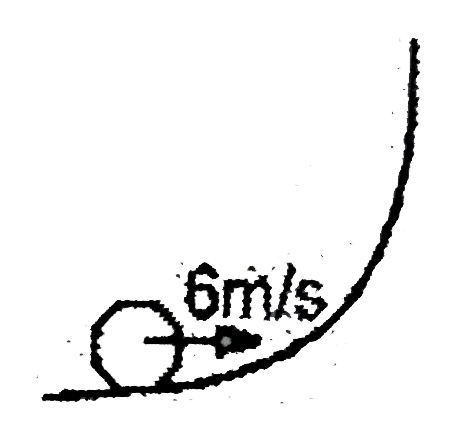A disc of radius 0.1 mrolls without sliding on a horizontal suirface with a velocity of 6 ms. It then ascends a smooth continous track as shown in figure. The height upto which it will ascend is (g=)

2.4 m
0.9 m
2.7 m
1.8 m
The correct Answer is:D
Topper's Solved these Questions
- ROTATIONAL MOTIONBOOK - DC PANDEYCHAPTER - ROTATIONAL MOTIONEXERCISE - More than one option is correct
36 Videos
- ROTATIONAL MOTIONBOOK - DC PANDEYCHAPTER - ROTATIONAL MOTIONEXERCISE - Comprehension Type Questions
41 Videos
- ROTATIONAL MOTIONBOOK - DC PANDEYCHAPTER - ROTATIONAL MOTIONEXERCISE - Integer Type Questions
17 Videos
- ROTATIONAL MECHANICSBOOK - DC PANDEYCHAPTER - ROTATIONAL MECHANICSEXERCISE - Subjective Questions
2 Videos
- SEMICONDUCTORS AND ELECTRONIC DEVICESBOOK - DC PANDEYCHAPTER - SEMICONDUCTORS AND ELECTRONIC DEVICESEXERCISE - More than One Option is Correct
3 Videos
Similar Questions
A disc of radius 0.1 m rolls without sliding on a horizontal surface with a velocity of 6ms−1 . It then ascends a smooth continuous track as shown in figure. The height upto which it will ascend is (g=10ms−2)

View SolutionA wheel ( to be considered as a ring ) of mass m and radius R rolls without sliding on a horizontal surface with constant velocity v. It encounters a step of height R/2 at which it ascends without sliding

View Solution
Knowledge Check
A disc of radius 0.1m rolls without sliding on a horizontal surface with a velocity of 6m/s. It then ascends a smooth continuous track as shwon in figure. The height upto which it will ascend is (g=10m/s2)
 A2.4mB0.9mC2.7mD1.8m
A2.4mB0.9mC2.7mD1.8mA wheel ( to be considered as a ring ) of mass m and radius R rolls without sliding on a horizontal surface with constant velocity v. It encounters a step of height R/2 at which it ascends without sliding
 Athe angular velocity of the ring just after it comes in contact with step is 3v/4RBthe normal reaction due to the step on the wheel just after the impact is mg2−9mv216RCthe normal reaction due to the step on the wheel increases as the wheel ascends.Dthe friction will be absent during the ascent.
Athe angular velocity of the ring just after it comes in contact with step is 3v/4RBthe normal reaction due to the step on the wheel just after the impact is mg2−9mv216RCthe normal reaction due to the step on the wheel increases as the wheel ascends.Dthe friction will be absent during the ascent.A disc of radius R and mass M is rolling horizontally without slipping with speed with speed v. It then moves up an incline as shown in figure. The maximum height upto which it can reach is.
 .Av2/gBv2/2gCv2/3gD3v2/4g
.Av2/gBv2/2gCv2/3gD3v2/4g
A disc of mass M and radius R rolls on a horizontal surface and then rolls up an inclined plane as shown in the figure. If the velocity of the disc is v, the height to which the disc will rise will be:

View SolutionA disc of mass M and radius R rolls on a horizontal surface and then rolls up an inclined plane as shown in the figure. If the velocity of the disc is v, the height to which the disc will rise will be:

View SolutionA particle is thrown with a velocity of u m/s. It passes A and B as shown in figure at time t1 = 1 s and t2 = 3 s. The value of u is (g = 10 m/s2)

View SolutionA disc of mass 2 kg is rolling on a horizontal surface without slipping with a velocity of 0.1 m/s. What is its rotational kinetic energy?
View SolutionA circular disc of mass 0.41 kg and radius 10 m rolls without slipping with a velocity of 2 m/s. The total kinetic energy of disc is
View Solution
